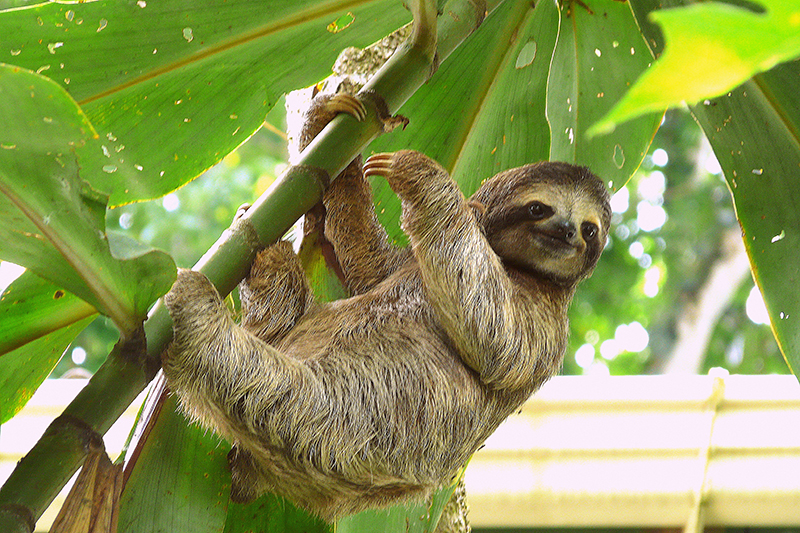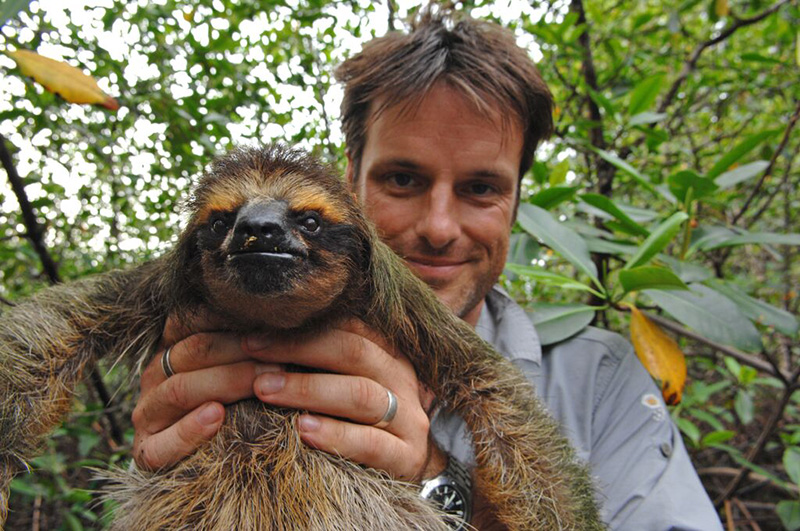“Their eyes are dull, and almost concealed with hair; their mouths are wide, and their lips thick and heavy; their fur is coarse, and looks like dried grass; their thighs seem almost disjointed from the haunches; their legs very short and badly shaped….the inertia of this animal is not so much due to laziness as to wretchedness; it is the consequence of its faulty structure, inactivity, stupidity, and even habitual suffering result from its strange and uncouth formation…. An imperfect sketch of nature…..one more defect and they could not have existed.”
It’s safe to say that the great 18th Century French Naturalist Georges-Louis Leclerc, Comte de Buffon had it in for the sloth; seeing it as a good for nothing, lazy, stupid ‘error of nature’. He couldn’t look beyond his prejudices and see an animal that is far from an evolutionary disaster – but one of the world’s most successful mammals.
On your expedition to Central America, we will be passing through some of the best habitats for these animals, and while we hope to see them (and rarely does a trip to Central America turn up a blank), the fact is we miss many, many more.

So significant are these animals in the day to day nutrient cycles of the forest, it is said that if you were to add up the weights of all the mammals in the rain forests; not just the sloths, but all the Jaguars, Pacas, Agoutis, squirrels, Howler Monkeys, Armadillos, anteaters etc. etc. the sloths (both three-toed and Hoffmann’s Three-toed sloth) would come out accounting for over two-thirds of all the mammal biomass and between them. And they would account for over half of the energy consumption of all the terrestrial mammals! In short, a neotropical mammal doesn’t come much more successful than the sloth, and this is in part to their ability to make a meal out of the most abundant foodstuff in the forest – and that is the forest itself.
Pound for pound, sloths are THE most ecologically successful mammal of Central and South America. You see, everything about sloths is focussed on their ability to take the relatively tough and indigestible leaves and squeeze an existence out of them. Not on their own you understand, with more than a little help from their friends; and by friends I mean the billions of cellulose-digesting gut bacteria that each sloth houses in its long and bulky gut – they are in effect, hanging fermentation baskets!
To help the fermentation process out, the sloth has ruminants such as cattle and deer, a multi-chambered stomach. This includes one compartment that acts like large fermentation tank – so big is this vat that when full it takes up most of the body cavity and accounts for some 20-30% of its body weight, even with the bacteria doing all the hard grind.
It can take over four weeks for food to pass the entire length of its gut, but even then there isn’t a tremendous amount of nutrition to be had – and so it follows that the sloth applies many other tricks of adaptation to maximize its efficiency and minimize its energy budget.
For a start a sloth has a low metabolism, and runs its body temperature more economically than most mammals, between 30 – 34 ℃ when active. This helps save substantially on heating bills, and it is the reason why, along with its inability to shiver (another high energy activity the sloth has evolved to go without), a sloth is covered in thick insulating fur. In fact, like the green Iguanas that you’ll see soaking up the first of the sun’s rays in the morning, the sloth will also bask to raise its body temperature enough to get on with the process of digestion – a metabolic status known as Heterothermic, their body temperature fluctuates with that of its environment. To further reduce energy consumption, muscle mass is low too – less than 20-30% of body weight compared with some 40-50% in most mammals of their size. Their reduced musculature and body temperature means they are slow, but then they don’t need to move very fast.. their food doesn’t run away and other than being on the menu of large birds of prey, such as Harpy eagles, they have very few predators to run away from.

They are exceptionally well camouflaged. Their lack of movement for a start doesn’t draw the eye and if you look at their hair, which under a microscope you’ll notice it has longitudinal grooves (in the two-toed) and cracks and crevices (found in the three-toed ), these are populated with algae. Giving the sloth a greenish tinge – a beneficial relationship as not only does it provide a form of further camouflage, but there is a theory that the algae itself produce compounds that the sloth can absorb through its skin or consume by licking. In fact, the only time sloths are relatively easy to spot is when they are in the open-canopied Cecropia trees – a phenomenon that leads to the once erroneous belief that the Three-toed sloth only fed on this tree.
Hanging around
Adaptations to hanging upside down are also numerous – each limb terminates in long recurved claws, and all the ankle and wrist bones have fused and are bound tightly together with connective tissue with little lateral movement. If you or I were to hang upside down and mimic the sloth, it would utilize quite a bit of energy as we would actively have to tense muscles to maintain a grip and stop ourselves from falling – not the sloths. Their claws act a bit like coat hangers, they hook over the branches and the rest of the sloth is in effect suspended – sloths often die in the trees and will continue to hang there until decomposition causes them to fall to pieces.
Its skeletal musculature is made up of high numbers of retractor muscles and, while in most mammals like us we have paired muscles that work together to extend and then contact an arm, for example, a sloth uses gravity to do most of the extensor muscles work and only uses the retractor muscles to pull food towards its mouth. Several muscles that would be extensor muscles in other mammals have been modified to be contractor muscles in the sloth. This combined with other unusual skeletal features such as; a high number of neck vertebrae (the three-toed sloth usually has nine and the two-toed sloth has between six and nine cervical vertebrae) and flexible spine and loose limb joints, means the sloth can reach around, bend around and look around all from the same spot – yet another energy-conserving adaptation.
Sloths are at one with gravity. While most terrestrial mammals are all about fighting it, these mammals are all about utilizing it. Even the simple things which might be a design flaw are worked around uniquely. Just take that massive gut; if we were proportionally the same, our stomach would crush our other organs including our lungs and make taking a breath an impossibility. In the sloth, hanging upside down, its stomach is attached to the lower portion of its ribcage in several places, effectively suspended within the body cavity. This is possibly a reason the sloth has so many ribs for such a short animal – 46 to be precise…. one of the many factors that made Compte du Buffon conclude that this sort of excess made the animal such a mistake of nature.
Sloths as a habitat
As well as the usual collection of freeloaders and parasites such as ticks and mites (several of which are unique to sloths) there are several species of Sloth Moth, beetles (over 900 individual beetles have been recovered from one sloth) mites and flies that live commensally among the fur of the sloth. Here they feed on skin secretions and the algae itself – this complete eco-system on its back doesn’t seem to affect the sloth in any way. In fact, it’s thought that they may be beneficial as many of these animals will help fertilize the algae which benefit the sloth in other ways.
The larvae of the moths and the beetles develop in the Sloths feces. In the mammals weekly vertical migration to the forest floor to carefully defecate at the base of a tree, the moths and beetles can hop off and lay their eggs before jumping back on their host (as with other actives sloths take a long time in their ablutions). Why the sloth goes to all this bother is something of a mystery. Maybe it’s a way of fertilizing and giving back to the trees in which the sloth inhabit and feed?
Are sloths slothful?
Not really. Recent studies have found that they are no lazier than any other mammal, sleeping for 8-9 hours in every 24 hours. It’s just that they do things very differently; slowly. While this lack of apparent activity may have us conclude that a sloth does nothing; the truth is it’s doing everything it needs to. But due to its highly specialized adaptations to exploiting the most abundant resource in the rain forest, it does this very, very slowly and economically – a sloth is a perfect way to live in the rainforest as its numbers attest. In fact, you could argue that along with its ability to fill an ecological void, it also fills a physical space that would otherwise simply be taken up by air, that the rainforest is as much part of the sloth as the sloth is rainforest, a fact that many sloth moths, beetles and algae species would agree with.
We will probably come across two of the six species of sloth – the Brown-throated Three-toed sloth (Bradypus variegatus) and Hoffman’s Two-toed Sloth (Choloepus hoffmanni) on our travels. You don’t need to be able to count the claws to separate them – although as their name suggests they have varying numbers of claws on the front limbs only. The Two-toed is nocturnal and slightly more blond and plain to look at, while the Three-toed is more grizzled and has a distinctive dark mask around the eyes, a pale face and in the males a strange orange shield-like oil gland on the back.
Thanks to Nick Baker for the fascinating insight into sloths. If you would like to book our Central America voyage, please contact your preferred agent or our sales team here.















